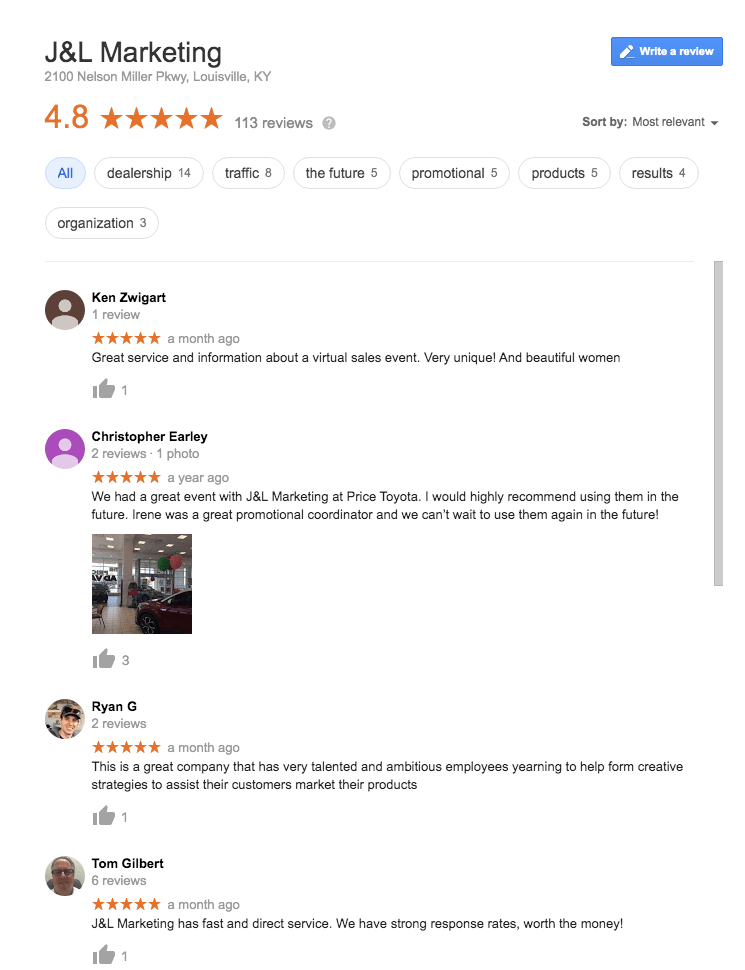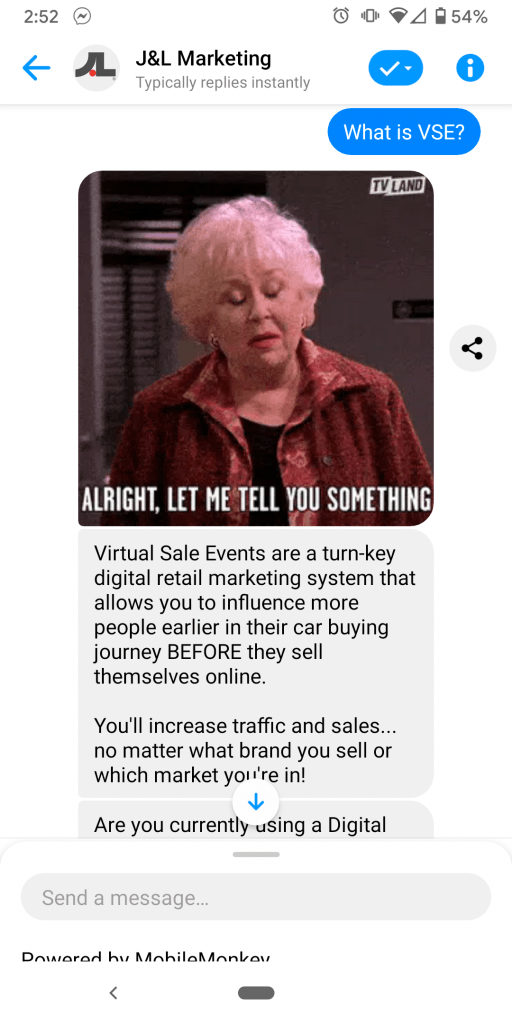Think about the last time you purchased a car from somewhere other than your dealership. What was that experience like?
Were you able to easily navigate the dealership’s website and request a test drive? Did the sales team go above and beyond to ensure your needs were met? Was the sales process seamless and simple? Did the dealership have amenities that aided your overall experience? Was the sales team there for you long after you made a purchase?
All of these factors — and more — play into a customer’s satisfaction with your dealership. And, unless you can read minds, it is difficult to know what a customer truly thinks about your business.
Fortunately, we live in an age where technology is readily accessible and provides long-term benefits to customers and dealerships alike.
Measure how satisfied customers are with your dealership by leveraging these six types of technology, many of which you’re likely already using.
1. Customer Reviews
Every business has a love/hate relationship with review sites like Google, Yelp, Facebook, etc. Yet, these sites are one of the most accessible ways to determine how happy customers are with your dealership.
Take time to analyze each customer review in depth. Ask yourself:
- What is the customer pleased or frustrated with?
- Did this situation need to happen, or was human error or oversight involved?
- What can you do to remedy or improve the customer’s experience?
- How can you replicate the positive experience for future customers?
Of course, you may encounter a few bad reviews while scrolling through Google or Facebook. Keep in mind that it’s impossible to please everyone! Use undesirable reviews as an opportunity to identify issues that may prevent customers from being satisfied with your dealership.
If possible, respond to each review — both good and bad — to show the user you care about and listen to their feedback. Use these templates as a foundation for your response. Who knows? You might have the chance to rectify a dissatisfied customer’s experience!

2. Customer Surveys
Customer surveys are a common and effective way to measure customer satisfaction. Your surveys can be as simple or as detailed as you desire, as long as they are delivered in the right context.
There are several survey methods available to car dealerships, including:
In-App/Online Surveys
When customers are using your website or app to schedule a service appointment, browse through your current inventory, or learn more about your dealership, offer them the opportunity to rate their experience.
The beauty of this technology is the ability to cater the survey to your goals.
For instance, if you want to learn more about a customer’s encounter with your online service scheduling system, include a quick survey at the end of the scheduling process asking, “On a scale of 0-10, how would you rate your experience with our booking process?”
Or, if you want to see how your sales team interacts with customers, include a link to a survey in each of their email signatures. When your sales professionals email prospective buyers or loyal customers, customers will have the chance to share their experiences with your team.
These surveys can also be displayed on your customer-facing POS system at the end of service-centers or parts transactions for further customer insight.
The trick to obtaining more responses is to make the surveys as straightforward as possible. Unless there is an incentive involved, customers will rarely be willing to sit down and answer a 20+ question survey.
To make your surveys effective for employees and customers alike, use popular survey tools such as:
Net Promoter Score
Another survey tactic used by car dealerships is known as the Net Promoter Score (NPS). This survey measures how willing a customer is to recommend your dealership’s products and services to others. The score ranges from -100 to 100.
Customers are simply asked, “On a scale of 0-10, how likely are you to recommend our dealership’s products and services to family and friends.” Based on their answers, customers fall into one of three categories:
- Promoters: Answered 9 or 10
- Passives: Answered 7 or 8
- Detractors: Answered 6 or below
Your dealership’s NPS is then calculated using the following equation:
NPS = % of Promoters – % of Detractors
Let’s imagine you had 10 survey participants and received 3 detractors, 3 passives, and 4 promoters. Using the equation, you would receive a Net Promoter Score of 10 (40% – 30%).
Naturally, you should strive to continuously improve your dealership’s Net Promoter Score and, in turn, the customer’s experience at your facility.
3. In-Store Kiosks
Wondering what customers think about your dealership and their car buying experience? Ask them!
Set up in-store kiosks for customers to submit anonymous feedback or take a quick interactive survey about their experience.
Place these kiosks in high-traffic areas of your lobby or service center to entice customers to participate. Of course, you can always add an incentive such as a gift card or a chance to win a prize for participating.
4. Chatbots
In addition to being a phenomenal customer service tool, chatbots can help you measure how pleased your customers are.
After the end of a customer conversation, program the chatbot to ask the user about their experience. This could be in the form of a quick survey or an open-ended question — your choice!
Or, if rather than preprogrammed responses, an individual on your team controls your chatbot, encourage them to engage the customer in an informal survey after each conversation.
When working with programmed chatbots, ensure that the conversation surrounding customer satisfaction flows naturally with the conversation. Abruptly asking a customer to fill out a survey or select a response will only result in dissatisfaction or a lack of replies.

5. Google Analytics
An indirect way to understand how customers feel about your business is to audit your Google Analytics reports.
While Google Analytics can’t provide qualitative data such as insight about a particular customer’s interaction with your dealership, it can give you a glimpse into the overall satisfaction of your online audience through metrics such as:
- Bounce Rate: Are customers landing on your website and leaving before visiting another page or filling out a form?
- User Flow: What pages are customers looking at, and in which order?
- Time Spent on Site: How long are customers spending on your website?
- Goals: Set specific action goals, such as form submissions, to track customer satisfaction as well.
- New vs. Returning Customers: Are your current customers returning for more information or booking service appointments?
Use Google Analytics data as supplemental customer satisfaction insight. It cannot tell you exactly how a consumer feels or thinks, but it can shed light on their online behaviors.
6. Social Media Monitoring
When a customer has a bad experience, where’s the first place they turn to? Social media!
Twitter, in particular, is filled with users tagging companies to obtain remedies to their bad experiences. The best brands utilize a social media monitoring and listening strategy and immediately act on these customer complaints.
Of course, you’ll enjoy your fair share of positive social media interactions, too! From customers posting about their brand-new car purchases to leaving glowing recommendations about your service team, consumers will share their overwhelmingly positive business interactions with others online.
You can also use specific tools to alert you every time your brand is mentioned — whether they tagged your account or not. Plus, many of these tools scour the Internet looking for mentions of your dealership in blogs, article comments, and more. It’s not limited to social media!
Some of the best social media monitoring tools include:
To get the most out of these tools, assign a specific person from your customer service and/or marketing teams to utilize the platforms and respond to complaints, concerns, and positive interactions in a timely manner.
4 Quick Steps for Improving Customer Satisfaction at Your Dealership
If you use these tools and technology only to discover that your customers are far from satisfied, use these quick steps to implement at your dealership:
1. Identify the Problem
After combing through customer reviews, survey responses, and emails, do you notice a pattern? Are there any problems that consistently appear in customer responses? If so, identify these problems immediately.
It’s not enough to acknowledge the problems. Document them and distribute the list to your team. Fixing these issues will require buy-in and support from every member of your team.
2. Develop Solutions
Sometimes the problem isn’t caused by an individual on your team. Often, it’s the result of poor internal systems, technology, or mismanaged processes. Work together with your respective teams and brainstorm for potential solutions to your customer problems.
Possible solutions can include adopting new technology, revising company processes, restructuring teams, and more.
3. Take Action
After formulating a concrete plan with your employees, put it to work. Don’t delay. Do it now!
4. Review & Adapt
Use the technology mentioned previously to continue monitoring your customers’ satisfaction. Did the new changes affect their experience with your dealership? Did things improve, or is there more work to do?
Customer satisfaction is a constantly evolving concern for all business owners, so keep at it!
Customer Satisfaction Stems From All Aspects of Your Dealership
From your service events to your online ads, all customer touchpoints factor into their overall experience with your business. Let the team at J&L Marketing help you with your marketing, events, and advertising so you can focus on providing customers the best service possible.



